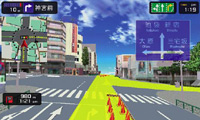 Sony’s new range of in-car navigation systems, the NV-XYZ 33, 55 and 77 feature remarkably advanced 3D mapping, media players, GPS, hard drives and based on the Linux kernel.
Sony’s new range of in-car navigation systems, the NV-XYZ 33, 55 and 77 feature remarkably advanced 3D mapping, media players, GPS, hard drives and based on the Linux kernel.
The 3D mapping interface is clear and brightly coloured, and features representations of the actual buildings that you’re driving past to find that little store in Akihabara that has some of those Tom Nook figurines left over. In fact, the 800 x 480 pixel touch screen display throws around so many pastel polygons it looks just like Crazy Taxi. Depending on your driving style, of course.
Advertising for petrol stations and fast food outlets are built into the maps, making the 3D world you’re driving through even more accurate/annoying.
As the systems are for the Japanese market exclusively, maps are only available for Tokyo and other locations in the country.
Other software supplied with the units include a web browser, an email client and a word processor (no doubt for filing out those insurance claims after being distracted by too many in-car gadgets).
The 200 x 104 x 49 mm units are based on a MontaVista Hard-Hat Linux distribution, all models have CF card sockets for wireless cards and a USB2.0 interface for connecting to your PC. DVDs can be downloaded to the unit’s hard drive for viewing on the road.
The units are priced at 155,400 (33), 176,000 (55) and 207,900 (77) yen respectively. (€1164, €1319 and €1558).